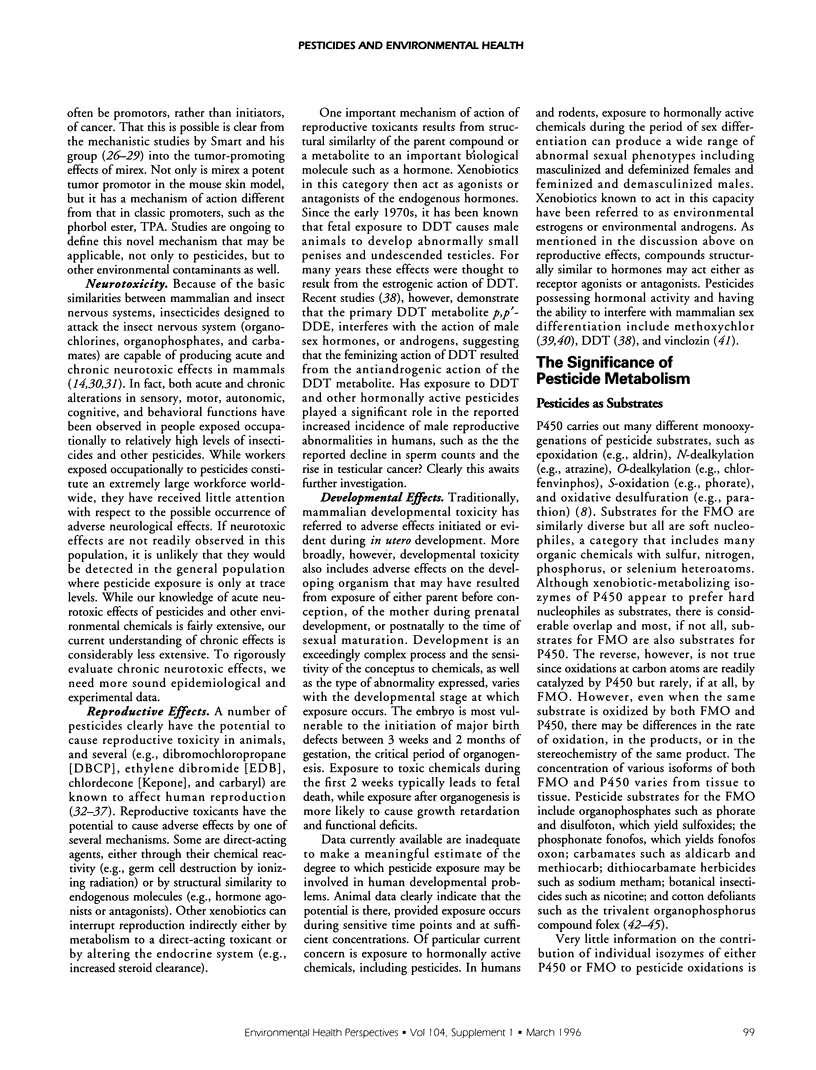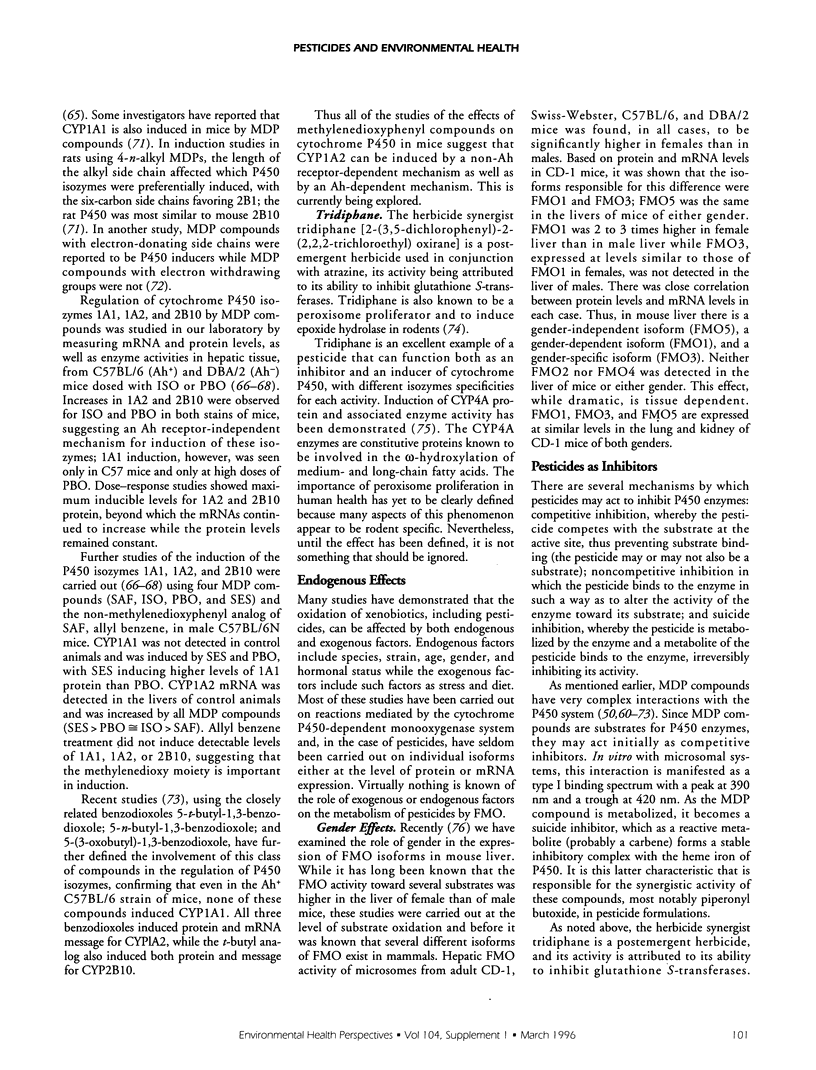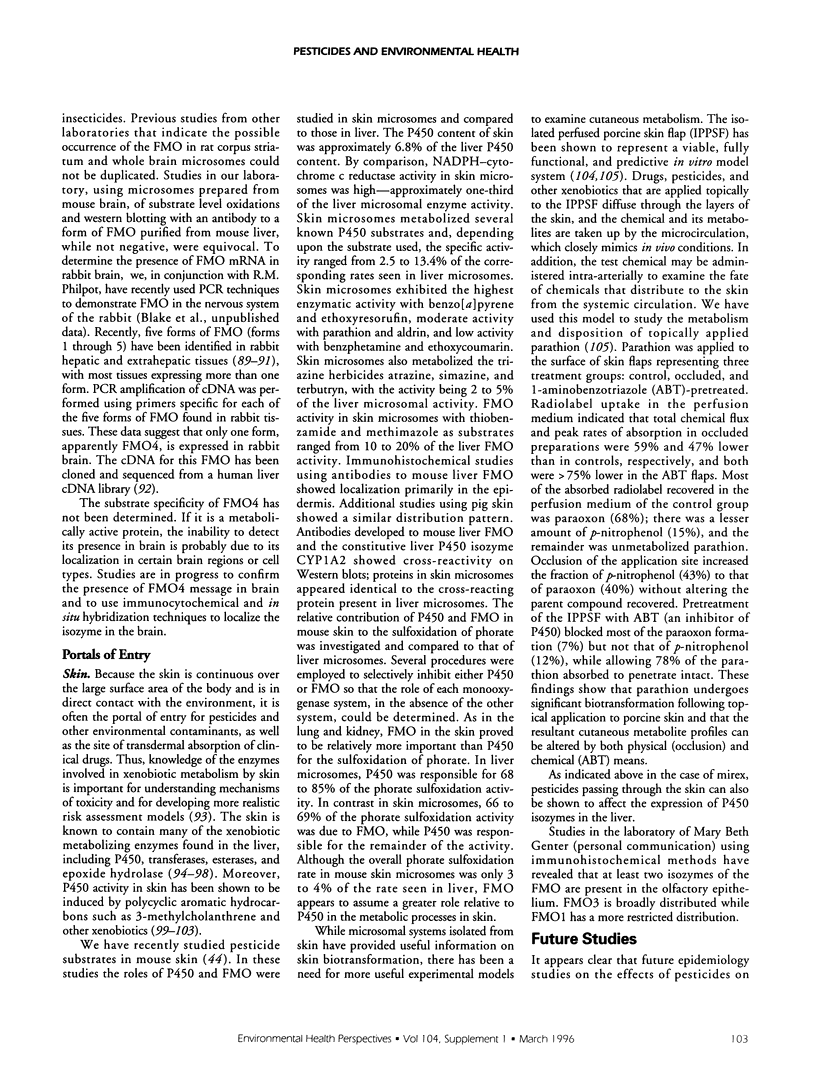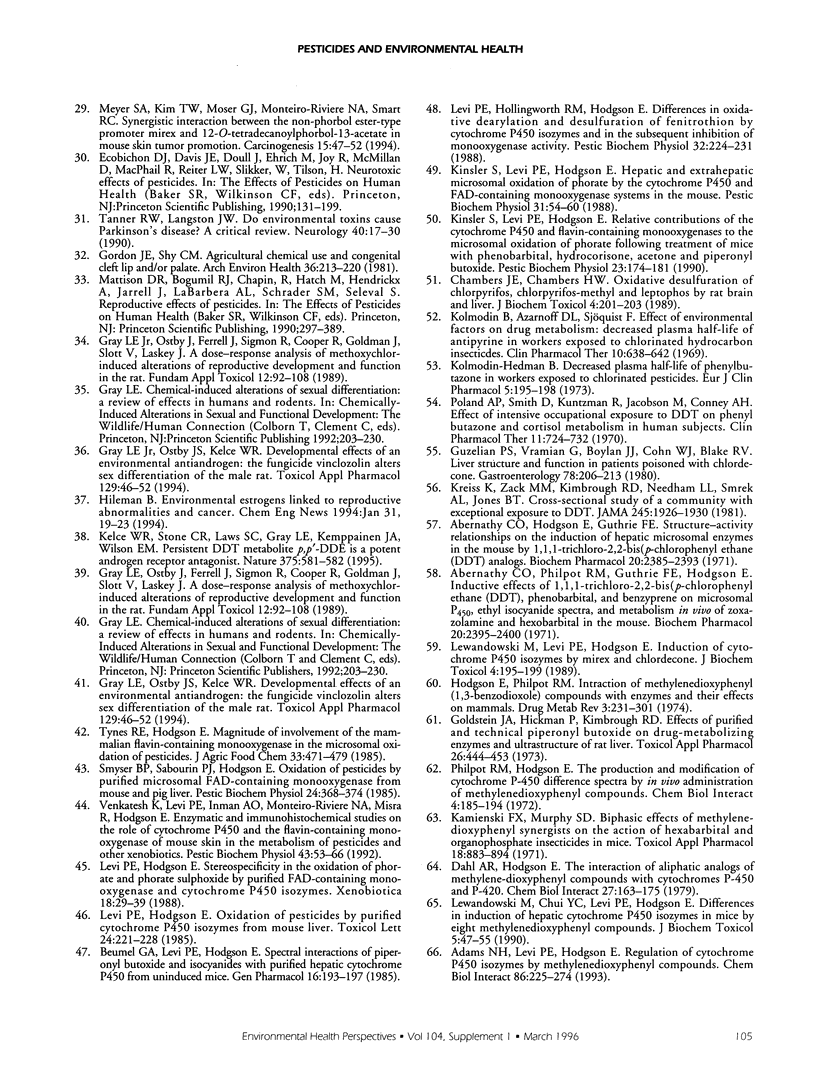Abstract
Pesticides are high-volume, widely used, environmental chemicals and there is continuous debate concerning their possible role in many chronic human health effects. Because of their known structures, known rates of application, and the presence of a large occupationally exposed population, they are not only important in their own right but are ideal models for the effects of environmental chemicals on the population in general. For reasons that are not always clear, this potential has not been realized. These exposed populations represent an underused asset in the study of the human health effects of environmental contaminants. Chronic effects thought to involve pesticides include carcinogenesis, neurotoxicity, and reproductive and development effects. In this paper we attempt to summarize this concern and, relying to a large extent on studies in our own laboratory, to indicate the importance and present status of studies of the mammalian metabolism of pesticides and indicate the need for further use of this model. Aspects considered include the role of pesticides as substrates for xenobiotic-metabolizing enzymes such as cytochrome P450 and the flavin-containing monooxygenase and their role as inducers or inhibitors of metabolic enzymes. The interaction of pesticides with complex multienzyme pathways, the role of biological characteristics, particularly gender, in pesticide metabolism, and the special role of pesticides at portals of entry and in target tissues are also considered.
Full text
PDF









Selected References
These references are in PubMed. This may not be the complete list of references from this article.
- Abernathy C. O., Hodgson E., Guthrie F. E. Structure-activity relationships on the induction of hepatic microsomal enzymes in the mouse by 1,1,1-trichloro-2,2-bis(p-chlorophenyl) ethane(DDT) analogs. Biochem Pharmacol. 1971 Sep;20(9):2385–2393. doi: 10.1016/0006-2952(71)90238-3. [DOI] [PubMed] [Google Scholar]
- Abernathy C. O., Philpot R. M., Guthrie F. E., Hodgson E. Inductive effects of 1,1,1-trichloro-2,2-bis(p-chlorophenyl)ethane(DDT), phenobarbital, and benzpyrene on microsomal cytochrome B450, ethyl isocyanide spectra, and metabolism in vivo of zoxazolamine and hexobarbital in the mouse. Biochem Pharmacol. 1971 Sep;20(9):2395–2400. doi: 10.1016/0006-2952(71)90239-5. [DOI] [PubMed] [Google Scholar]
- Adams N. H., Levi P. E., Hodgson E. Regulation of cytochrome P-450 isozymes by methylenedioxyphenyl compounds. Chem Biol Interact. 1993 Mar;86(3):255–274. doi: 10.1016/0009-2797(93)90101-4. [DOI] [PubMed] [Google Scholar]
- Beumel G. A., Levi P. E., Hodgson E. Spectral interactions of piperonyl butoxide and isocyanides with purified hepatic cytochrome P-450 from uninduced mice. Gen Pharmacol. 1985;16(3):193–197. doi: 10.1016/0306-3623(85)90068-0. [DOI] [PubMed] [Google Scholar]
- Bickers D. R., Wroblewski D., Tapu-Dutta-Choudhury, Mukhtar H. Induction of neonatal rat skin and liver aryl hydrocarbon hydroxylase by coal tar and its constituents. J Invest Dermatol. 1982 Mar;78(3):227–229. doi: 10.1111/1523-1747.ep12506525. [DOI] [PubMed] [Google Scholar]
- Blair A., Dosemeci M., Heineman E. F. Cancer and other causes of death among male and female farmers from twenty-three states. Am J Ind Med. 1993 May;23(5):729–742. doi: 10.1002/ajim.4700230507. [DOI] [PubMed] [Google Scholar]
- Blair A., Malker H., Cantor K. P., Burmeister L., Wiklund K. Cancer among farmers. A review. Scand J Work Environ Health. 1985 Dec;11(6):397–407. doi: 10.5271/sjweh.2208. [DOI] [PubMed] [Google Scholar]
- Blake B. L., Rose R. L., Mailman R. B., Levi P. E., Hodgson E. Metabolism of thioridazine by microsomal monooxygenases: relative roles of P450 and flavin-containing monooxygenase. Xenobiotica. 1995 Apr;25(4):377–393. doi: 10.3109/00498259509061859. [DOI] [PubMed] [Google Scholar]
- Brown L. M., Blair A., Gibson R., Everett G. D., Cantor K. P., Schuman L. M., Burmeister L. F., Van Lier S. F., Dick F. Pesticide exposures and other agricultural risk factors for leukemia among men in Iowa and Minnesota. Cancer Res. 1990 Oct 15;50(20):6585–6591. [PubMed] [Google Scholar]
- Chambers J. E., Chambers H. W. Oxidative desulfuration of chlorpyrifos, chlorpyrifos-methyl, and leptophos by rat brain and liver. J Biochem Toxicol. 1989 Fall;4(3):201–203. doi: 10.1002/jbt.2570040310. [DOI] [PubMed] [Google Scholar]
- Colborn T., vom Saal F. S., Soto A. M. Developmental effects of endocrine-disrupting chemicals in wildlife and humans. Environ Health Perspect. 1993 Oct;101(5):378–384. doi: 10.1289/ehp.93101378. [DOI] [PMC free article] [PubMed] [Google Scholar]
- Cook J. C., Hodgson E. Induction of cytochrome P-450 in congenic C57BL/6J mice by isosafrole: lack of correlation with the Ah locus. Chem Biol Interact. 1986 May;58(2):233–240. doi: 10.1016/s0009-2797(86)80100-4. [DOI] [PubMed] [Google Scholar]
- Cook J. C., Hodgson E. The induction of cytochrome P-450 by isosafrole and related methylenedioxyphenyl compounds. Chem Biol Interact. 1985 Aug-Sep;54(3):299–315. doi: 10.1016/s0009-2797(85)80171-x. [DOI] [PubMed] [Google Scholar]
- Dahl A. R., Hodgson E. The interaction of aliphatic analogs of methylene-dioxyphenyl compounds with cytochromes P-450 and P-420. Chem Biol Interact. 1979 Oct;27(2-3):163–175. doi: 10.1016/0009-2797(79)90123-6. [DOI] [PubMed] [Google Scholar]
- Davis D. L., Bradlow H. L., Wolff M., Woodruff T., Hoel D. G., Anton-Culver H. Medical hypothesis: xenoestrogens as preventable causes of breast cancer. Environ Health Perspect. 1993 Oct;101(5):372–377. doi: 10.1289/ehp.93101372. [DOI] [PMC free article] [PubMed] [Google Scholar]
- Dolphin C., Shephard E. A., Povey S., Palmer C. N., Ziegler D. M., Ayesh R., Smith R. L., Phillips I. R. Cloning, primary sequence, and chromosomal mapping of a human flavin-containing monooxygenase (FMO1). J Biol Chem. 1991 Jul 5;266(19):12379–12385. [PubMed] [Google Scholar]
- Falls J. G., Blake B. L., Cao Y., Levi P. E., Hodgson E. Gender differences in hepatic expression of flavin-containing monooxygenase isoforms (FMO1, FMO3, and FMO5) in mice. J Biochem Toxicol. 1995 Jun;10(3):171–177. doi: 10.1002/jbt.2570100308. [DOI] [PubMed] [Google Scholar]
- Goerz G., Bolsen K., Kalofoutis A., Tsambaos D. Influence of oral isotretinoin on hepatic and cutaneous P-450-dependent isozyme activities. Arch Dermatol Res. 1994;286(2):104–106. doi: 10.1007/BF00370735. [DOI] [PubMed] [Google Scholar]
- Goldstein J. A., Hickman P., Kimbrough R. D. Effects of purified and technical piperonyl butoxide on drug-metabolizing enzymes and ultrastructure of rat liver. Toxicol Appl Pharmacol. 1973 Nov;26(3):444–458. doi: 10.1016/0041-008x(73)90281-0. [DOI] [PubMed] [Google Scholar]
- Gordon J. E., Shy C. M. Agricultural chemical use and congenital cleft lip and/or palate. Arch Environ Health. 1981 Sep-Oct;36(5):213–221. doi: 10.1080/00039896.1981.10667627. [DOI] [PubMed] [Google Scholar]
- Gray L. E., Jr, Ostby J. S., Kelce W. R. Developmental effects of an environmental antiandrogen: the fungicide vinclozolin alters sex differentiation of the male rat. Toxicol Appl Pharmacol. 1994 Nov;129(1):46–52. doi: 10.1006/taap.1994.1227. [DOI] [PubMed] [Google Scholar]
- Gray L. E., Jr, Ostby J. S., Kelce W. R. Developmental effects of an environmental antiandrogen: the fungicide vinclozolin alters sex differentiation of the male rat. Toxicol Appl Pharmacol. 1994 Nov;129(1):46–52. doi: 10.1006/taap.1994.1227. [DOI] [PubMed] [Google Scholar]
- Gray L. E., Jr, Ostby J., Ferrell J., Rehnberg G., Linder R., Cooper R., Goldman J., Slott V., Laskey J. A dose-response analysis of methoxychlor-induced alterations of reproductive development and function in the rat. Fundam Appl Toxicol. 1989 Jan;12(1):92–108. doi: 10.1016/0272-0590(89)90065-1. [DOI] [PubMed] [Google Scholar]
- Gray L. E., Jr, Ostby J., Ferrell J., Rehnberg G., Linder R., Cooper R., Goldman J., Slott V., Laskey J. A dose-response analysis of methoxychlor-induced alterations of reproductive development and function in the rat. Fundam Appl Toxicol. 1989 Jan;12(1):92–108. doi: 10.1016/0272-0590(89)90065-1. [DOI] [PubMed] [Google Scholar]
- Guzelian P. S., Vranian G., Boylan J. J., Cohn W. J., Blanke R. V. Liver structure and function in patients poisoned with chlordecone (Kepone). Gastroenterology. 1980 Feb;78(2):206–213. [PubMed] [Google Scholar]
- Halpert J., Hammond D., Neal R. A. Inactivation of purified rat liver cytochrome P-450 during the metabolism of parathion (diethyl p-nitrophenyl phosphorothionate). J Biol Chem. 1980 Feb 10;255(3):1080–1089. [PubMed] [Google Scholar]
- Hodgson E., Levi P. E. The role of the flavin-containing monooxygenase (EC 1.14.13.8) in the metabolism and mode of action of agricultural chemicals. Xenobiotica. 1992 Sep-Oct;22(9-10):1175–1183. doi: 10.3109/00498259209051871. [DOI] [PubMed] [Google Scholar]
- Hodgson E., Philpot R. M. Interaction of methylenedioxyphenyl (1,3-benzodioxole) compounds with enzymes and their effects on mammals. Drug Metab Rev. 1974;3(2):231–301. doi: 10.3109/03602537408993744. [DOI] [PubMed] [Google Scholar]
- Jugert F. K., Agarwal R., Kuhn A., Bickers D. R., Merk H. F., Mukhtar H. Multiple cytochrome P450 isozymes in murine skin: induction of P450 1A, 2B, 2E, and 3A by dexamethasone. J Invest Dermatol. 1994 Jun;102(6):970–975. doi: 10.1111/1523-1747.ep12384210. [DOI] [PubMed] [Google Scholar]
- Kamataki T., Neal R. A. Metabolism of diethyl p-nitrophenyl phosphorothionate (parathion) by a reconstituted mixed-funcion oxidase enzyme system: studies of the covalent binding of the sulfur atom. Mol Pharmacol. 1976 Nov;12(6):933–944. [PubMed] [Google Scholar]
- Kamienski F. X., Murphy S. D. Biphasic effects of methylenedioxyphenyl synergists on the action of hexobarbital and organophosphate insecticides in mice. Toxicol Appl Pharmacol. 1971 Apr;18(4):883–894. doi: 10.1016/0041-008x(71)90236-5. [DOI] [PubMed] [Google Scholar]
- Kao J., Carver M. P. Cutaneous metabolism of xenobiotics. Drug Metab Rev. 1990;22(4):363–410. doi: 10.3109/03602539009041089. [DOI] [PubMed] [Google Scholar]
- Kelce W. R., Stone C. R., Laws S. C., Gray L. E., Kemppainen J. A., Wilson E. M. Persistent DDT metabolite p,p'-DDE is a potent androgen receptor antagonist. Nature. 1995 Jun 15;375(6532):581–585. doi: 10.1038/375581a0. [DOI] [PubMed] [Google Scholar]
- Khan W. A., Park S. S., Gelboin H. V., Bickers D. R., Mukhtar H. Epidermal cytochrome P-450: immunochemical characterization of isoform induced by topical application of 3-methylcholanthrene to neonatal rat. J Pharmacol Exp Ther. 1989 Jun;249(3):921–927. [PubMed] [Google Scholar]
- Khan W. A., Park S. S., Gelboin H. V., Bickers D. R., Mukhtar H. Monoclonal antibodies directed characterization of epidermal and hepatic cytochrome P-450 isozymes induced by skin application of therapeutic crude coal tar. J Invest Dermatol. 1989 Jul;93(1):40–45. doi: 10.1111/1523-1747.ep12277342. [DOI] [PubMed] [Google Scholar]
- Kolmodin B., Azarnoff D. L., Sjöqvist F. Effect of environmental factors on drug metabolism: decreased plasma half-life of antipyrine in workers exposed to chlorinated hydrocarbon insecticides. Clin Pharmacol Ther. 1969 Sep-Oct;10(5):638–642. doi: 10.1002/cpt1969105638. [DOI] [PubMed] [Google Scholar]
- Kreiss K., Zack M. M., Kimbrough R. D., Needham L. L., Smrek A. L., Jones B. T. Cross-sectional study of a community with exceptional exposure to DDT. JAMA. 1981 May 15;245(19):1926–1930. [PubMed] [Google Scholar]
- Krieger N., Wolff M. S., Hiatt R. A., Rivera M., Vogelman J., Orentreich N. Breast cancer and serum organochlorines: a prospective study among white, black, and Asian women. J Natl Cancer Inst. 1994 Apr 20;86(8):589–599. doi: 10.1093/jnci/86.8.589. [DOI] [PubMed] [Google Scholar]
- Kulkarni A. P., Hodgson E. Metabolism of insecticides by mixed function oxidase systems. Pharmacol Ther. 1980;8(2):379–475. doi: 10.1016/0163-7258(80)90054-6. [DOI] [PubMed] [Google Scholar]
- Lawton M. P., Cashman J. R., Cresteil T., Dolphin C. T., Elfarra A. A., Hines R. N., Hodgson E., Kimura T., Ozols J., Phillips I. R. A nomenclature for the mammalian flavin-containing monooxygenase gene family based on amino acid sequence identities. Arch Biochem Biophys. 1994 Jan;308(1):254–257. doi: 10.1006/abbi.1994.1035. [DOI] [PubMed] [Google Scholar]
- Lawton M. P., Philpot R. M. Molecular genetics of the flavin-dependent monooxygenases. Pharmacogenetics. 1993 Feb;3(1):40–44. doi: 10.1097/00008571-199302000-00004. [DOI] [PubMed] [Google Scholar]
- Levi P. E., Hodgson E. Oxidation of pesticides by purified cytochrome P-450 isozymes from mouse liver. Toxicol Lett. 1985 Feb-Mar;24(2-3):221–228. doi: 10.1016/0378-4274(85)90061-x. [DOI] [PubMed] [Google Scholar]
- Levi P. E., Hodgson E. Stereospecificity in the oxidation of phorate and phorate sulphoxide by purified FAD-containing mono-oxygenase and cytochrome P-450 isozymes. Xenobiotica. 1988 Jan;18(1):29–39. doi: 10.3109/00498258809055134. [DOI] [PubMed] [Google Scholar]
- Lewandowski M., Chui Y. C., Levi P. E., Hodgson E. Differences in induction of hepatic cytochrome P450 isozymes by mice in eight methylenedioxyphenyl compounds. J Biochem Toxicol. 1990 Spring;5(1):47–55. doi: 10.1002/jbt.2570050108. [DOI] [PubMed] [Google Scholar]
- Lewandowski M., Levi P., Hodgson E. Induction of cytochrome P-450 isozymes by mirex and chlordecone. J Biochem Toxicol. 1989 Fall;4(3):195–199. doi: 10.1002/jbt.2570040309. [DOI] [PubMed] [Google Scholar]
- Marcus C. B., Wilson N. M., Jefcoate C. R., Wilkinson C. F., Omiecinski C. J. Selective induction of cytochrome P450 isozymes in rat liver by 4-n-alkyl-methylenedioxybenzenes. Arch Biochem Biophys. 1990 Feb 15;277(1):8–16. doi: 10.1016/0003-9861(90)90543-8. [DOI] [PubMed] [Google Scholar]
- Meyer S. A., Kim T. W., Moser G. J., Monteiro-Riviere N. A., Smart R. C. Synergistic interaction between the non-phorbol ester-type promoter mirex and 12-O-tetradecanoylphorbol-13-acetate in mouse skin tumor promotion. Carcinogenesis. 1994 Jan;15(1):47–52. doi: 10.1093/carcin/15.1.47. [DOI] [PubMed] [Google Scholar]
- Meyer S. A., Moser G. J., Monteiro-Riviere N. A., Smart R. C. Minimal role of enhanced cell proliferation in skin tumor promotion by mirex: a nonphorbol ester-type promoter. Environ Health Perspect. 1993 Dec;101 (Suppl 5):265–269. doi: 10.1289/ehp.93101s5265. [DOI] [PMC free article] [PubMed] [Google Scholar]
- Moody D. E., Hammock B. D. The effect of tridiphane (2-(3,5-dichlorophenyl)-2-(2,2,2-trichloroethyl)oxirane) on hepatic epoxide-metabolizing enzymes: indications of peroxisome proliferation. Toxicol Appl Pharmacol. 1987 Jun 15;89(1):37–48. doi: 10.1016/0041-008x(87)90174-8. [DOI] [PubMed] [Google Scholar]
- Morelli M. A., Nakatsugawa T. Inactivation in vitro of microsomal oxidases during parathion metabolism. Biochem Pharmacol. 1978 Feb 1;27(3):293–299. doi: 10.1016/0006-2952(78)90231-9. [DOI] [PubMed] [Google Scholar]
- Moser G. J., Meyer S. A., Smart R. C. The chlorinated pesticide mirex is a novel nonphorbol ester-type tumor promoter in mouse skin. Cancer Res. 1992 Feb 1;52(3):631–636. [PubMed] [Google Scholar]
- Moser G. J., Robinette C. L., Smart R. C. Characterization of skin tumor promotion by mirex: structure-activity relationships, sexual dimorphism and presence of Ha-ras mutation. Carcinogenesis. 1993 Jun;14(6):1155–1160. doi: 10.1093/carcin/14.6.1155. [DOI] [PubMed] [Google Scholar]
- Mukhtar H., Bickers D. R. Drug metabolism in skin. Comparative activity of the mixed-function oxidases, epoxide hydratase, and glutathione S-transferase in liver and skin of the neonatal rat. Drug Metab Dispos. 1981 Jul-Aug;9(4):311–314. [PubMed] [Google Scholar]
- Murray M., Wilkinson C. F., Dube C. E. Induction of rat-hepatic microsomal cytochrome P-450 and aryl hydrocarbon hydroxylase by 1,3-benzodioxole derivatives. Xenobiotica. 1985 May;15(5):361–368. doi: 10.3109/00498258509045006. [DOI] [PubMed] [Google Scholar]
- Neal R. A., Halpert J. Toxicology of thiono-sulfur compounds. Annu Rev Pharmacol Toxicol. 1982;22:321–339. doi: 10.1146/annurev.pa.22.040182.001541. [DOI] [PubMed] [Google Scholar]
- Neal R. A., Sawahata T., Halpert J., Kamataki T. Chemically reactive metabolites as suicide enzyme inhibitors. Drug Metab Rev. 1983;14(1):49–59. doi: 10.3109/03602538308991380. [DOI] [PubMed] [Google Scholar]
- Nelson D. R., Kamataki T., Waxman D. J., Guengerich F. P., Estabrook R. W., Feyereisen R., Gonzalez F. J., Coon M. J., Gunsalus I. C., Gotoh O. The P450 superfamily: update on new sequences, gene mapping, accession numbers, early trivial names of enzymes, and nomenclature. DNA Cell Biol. 1993 Jan-Feb;12(1):1–51. doi: 10.1089/dna.1993.12.1. [DOI] [PubMed] [Google Scholar]
- Philpot R. M., Hodgson E. The production and modification of cytochrome P-450 difference spectra by in vivo administration of methylenedioxyphenyl compounds. Chem Biol Interact. 1972 Feb;4(3):185–194. doi: 10.1016/0009-2797(72)90013-0. [DOI] [PubMed] [Google Scholar]
- Poland A., Smith D., Kuntzman R., Jacobson M., Conney A. H. Effect of intensive occupational exposure to DDT on phenylbutazone and cortisol metabolism in human subjects. Clin Pharmacol Ther. 1970 Sep-Oct;11(5):724–732. doi: 10.1002/cpt1970115724. [DOI] [PubMed] [Google Scholar]
- Rettie A. E., Williams F. M., Rawlins M. D. Substrate specificity of the mouse skin mixed-function oxidase system. Xenobiotica. 1986 Mar;16(3):205–211. doi: 10.3109/00498258609043523. [DOI] [PubMed] [Google Scholar]
- Riviere J. E., Bowman K. F., Monteiro-Riviere N. A., Dix L. P., Carver M. P. The isolated perfused porcine skin flap (IPPSF). I. A novel in vitro model for percutaneous absorption and cutaneous toxicology studies. Fundam Appl Toxicol. 1986 Oct;7(3):444–453. doi: 10.1016/0272-0590(86)90094-1. [DOI] [PubMed] [Google Scholar]
- Rosenstock L., Keifer M., Daniell W. E., McConnell R., Claypoole K. Chronic central nervous system effects of acute organophosphate pesticide intoxication. The Pesticide Health Effects Study Group. Lancet. 1991 Jul 27;338(8761):223–227. doi: 10.1016/0140-6736(91)90356-t. [DOI] [PubMed] [Google Scholar]
- Ryu D. Y., Levi P. E., Hodgson E. Regulation of cytochrome P-450 isozymes CYP1A1, CYP1A2 and CYP2B10 by three benzodioxole compounds. Chem Biol Interact. 1995 Jun 14;96(3):235–247. doi: 10.1016/0009-2797(94)03594-x. [DOI] [PubMed] [Google Scholar]
- Smyser B. P., Levi P. E., Hodgson E. Interactions of diethylphenylphosphine with purified, reconstituted mouse liver cytochrome P-450 monooxygenase systems. Biochem Pharmacol. 1986 May 15;35(10):1719–1723. doi: 10.1016/0006-2952(86)90329-1. [DOI] [PubMed] [Google Scholar]
- Stone R. Environmental estrogens stir debate. Science. 1994 Jul 15;265(5170):308–310. doi: 10.1126/science.8023147. [DOI] [PubMed] [Google Scholar]
- Storm J. E., Collier S. W., Stewart R. F., Bronaugh R. L. Metabolism of xenobiotics during percutaneous penetration: role of absorption rate and cutaneous enzyme activity. Fundam Appl Toxicol. 1990 Jul;15(1):132–141. doi: 10.1016/0272-0590(90)90170-o. [DOI] [PubMed] [Google Scholar]
- Tanner C. M., Langston J. W. Do environmental toxins cause Parkinson's disease? A critical review. Neurology. 1990 Oct;40(10 Suppl 3):suppl 17–31. [PubMed] [Google Scholar]
- Tynes R. E., Hodgson E. Oxidation of thiobenzamide by the FAD-containing and cytochrome P-450-dependent monooxygenases of liver and lung microsomes. Biochem Pharmacol. 1983 Nov 15;32(22):3419–3428. doi: 10.1016/0006-2952(83)90371-4. [DOI] [PubMed] [Google Scholar]
- Uchiyama M., Yoshida T., Homma K., Hongo T. Inhibition of hepatic drug-metabolizing enzymes by thiophosphate insecticides and its drug toxicological implications. Biochem Pharmacol. 1975 Jun 15;24(11-12):1221–1225. doi: 10.1016/0006-2952(75)90066-0. [DOI] [PubMed] [Google Scholar]
- Wolff M. S., Toniolo P. G., Lee E. W., Rivera M., Dubin N. Blood levels of organochlorine residues and risk of breast cancer. J Natl Cancer Inst. 1993 Apr 21;85(8):648–652. doi: 10.1093/jnci/85.8.648. [DOI] [PubMed] [Google Scholar]
- Ziegler D. M. Flavin-containing monooxygenases: enzymes adapted for multisubstrate specificity. Trends Pharmacol Sci. 1990 Aug;11(8):321–324. doi: 10.1016/0165-6147(90)90235-z. [DOI] [PubMed] [Google Scholar]
- Ziegler D. M., Mitchell C. H. Microsomal oxidase. IV. Properties of a mixed-function amine oxidase isolated from pig liver microsomes. Arch Biochem Biophys. 1972 May;150(1):116–125. doi: 10.1016/0003-9861(72)90017-3. [DOI] [PubMed] [Google Scholar]
- Ziegler D. M. The 1990 Bernard B. Brodie Award Lecture. Unique properties of the enzymes of detoxication. Drug Metab Dispos. 1991 Sep-Oct;19(5):847–852. [PubMed] [Google Scholar]


